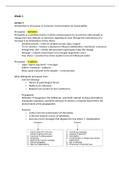Week 1
Lecture 1
Introduction to Persuasion in Consumer Communication for Sustainability
Persuasion – Definition:
Persuasion as a symbolic process in which communicators try to convince other people to
change their own attitudes or behaviors regarding an issue through the transmission of a
message in an atmosphere of free choice.
- Symbolic process > relies on symbols (words, signs, images)
- Try to convince > involves a attempt to influence (deliberative, intentional, conscious)
- Change their own > entails self-persuasion (persuadee make the change)
- Message > requires transmission of a message (arguments, cues)
- Free choice > assumes free choice (option to do not follow persuader
Persuasion – Traditions:
- Logos: logical arguments > messages
- Pathos: emotional > audience
- Ethos: good character of the speaker > communicator
What distinguish persuasion from:
- Coercion (Dwang)
o Nature of psychological threat
o Ability to do otherwise
o Request runs counter to one’s preference
- Propaganda
Definition: Propaganda is the deliberate, systematic attempt to shape perceptions,
manipulate cognitions, and direct behavior to achieve a response that furthers the
desired intent of the propagandist.
Features:
o Control over the transmission of information,
o Is directed towards masses of individuals,
o And uses covert messages that disguise the true intent (= manipulation)
,Readings
Bakir, V., Herring, E., Miller, D., & Robinson, P. (2019). Organized Persuasive Communication:
A new conceptual framework for research on public relations, propaganda and promotional
culture. Critical Sociology, 45(3), 311–328. https://doi.org/10.1177/0896920518764586
- Define what persuasive communication is
- Distinguish persuasion from manipulation and propaganda
SEE LECTURE SLIDES
Lecture 2
Persuasion as Rational Deliberation (rationale afweging)
Part 1: What are conditions for rational discourse and how are claims and contoveries
deliberated?
Ideal speech situations:
- Goal is reaching consensus
- Procedural rules: There is no coercion, equality, inclusiveness
- Logical rules: no contradictions, inconsistencies, or equivocations
- Ideal speech situations: The goal is reaching consensus. There is no coercion; equality
and inclusiveness (procedural rules). There is no contradictions, inconsistencies, or
equivocations.
- Presuppositions to agree on validity
o Sincerity (speakers’ authenticity)
o Truth (fact, an objective finding)
o Rightness (moral rules and principles)
, Types of discourses (redevoering) used for deliberation:
- Explicative discourse > Is it clear and understandable?
- Theoretical discourse > Is it true and effective?
- Practical discourse? Is it relevant and justified?
Part 2: What makes a strong argument and how do debates change levels
Two rhetorical approaches
Toulmin Argumentation and Flashpoint Warrants:
Naked claim is just an opinion, so it needs supporting evidence (a enthymeme: claim +
supporting evidence)





